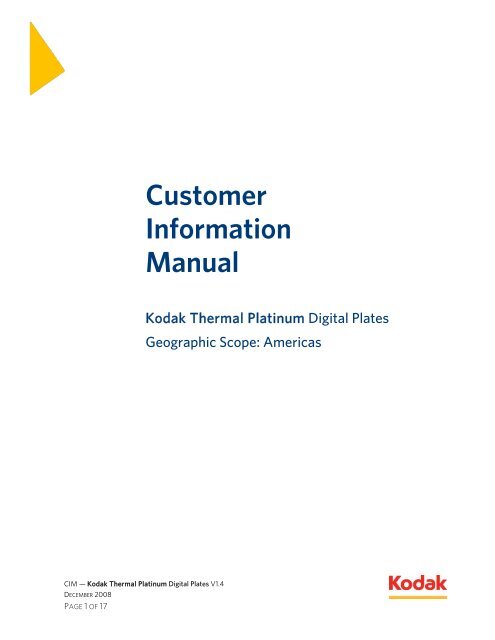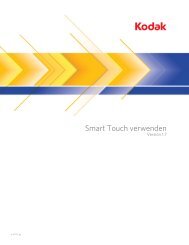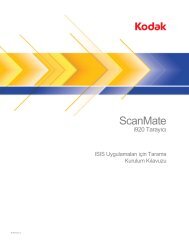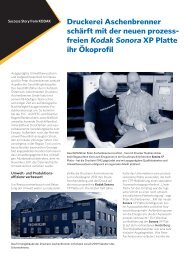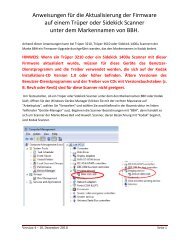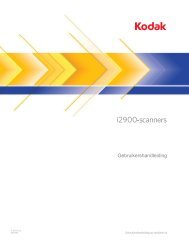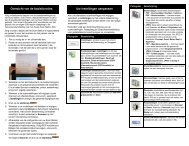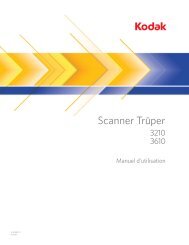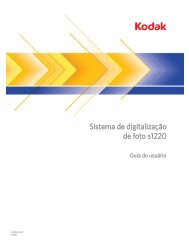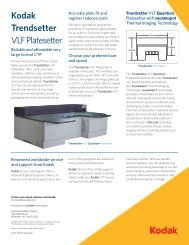Customer Information Manual - Kodak
Customer Information Manual - Kodak
Customer Information Manual - Kodak
Create successful ePaper yourself
Turn your PDF publications into a flip-book with our unique Google optimized e-Paper software.
CIM — <strong>Kodak</strong> Thermal Platinum Digital Plates V1.4<br />
DECEMBER 2008<br />
PAGE 1 OF 17<br />
<strong>Customer</strong><br />
<strong>Information</strong><br />
<strong>Manual</strong><br />
<strong>Kodak</strong> Thermal Platinum Digital Plates<br />
Geographic Scope: Americas
Table of Contents<br />
1.0 OPERATING, HANDLING & STORAGE CONDITIONS .................................................................3<br />
2.0 PRESS PERFORMANCE........................................................................................................................4<br />
3.0 THERMAL PLATINUM PLATE CHEMISTRY ...................................................................................5<br />
4.0 PROCESSOR SET-UP AND CONFIGURATION...............................................................................6<br />
4.1 PROCESSOR CONFIGURATION............................................................................................................................. 6<br />
4.2 PROCESSOR LINE SETUP ........................................................................................................................................7<br />
5.0 PREHEAT AND POSTBAKE OVEN SETUP AND CONFIGURATION..........................................8<br />
5.1 FIND THE FOG POINT AND SET OVEN TEMPERATURE ..................................................................................... 8<br />
5.2 POSTBAKE OVEN SETUP.......................................................................................................................................11<br />
6.0 PRESS CHEMISTRY COMPATIBILITY FOR UNBAKED/BAKED THERMAL PLATINUM<br />
PLATES ............................................................................................................................................................... 12<br />
6.1 CHEMICAL COMPATIBILITY ................................................................................................................................13<br />
APPENDIX A...................................................................................................................................................... 14<br />
TROUBLESHOOTING ............................................................................................................................................................14<br />
APPENDIX B ...................................................................................................................................................... 15<br />
PROCESSING LINE MAINTENANCE ....................................................................................................................................15<br />
DEVELOPER SYSTEM CLEANING ........................................................................................................................................16<br />
SYSTEM CLEANING PROCEDURE ........................................................................................................................................16<br />
CIM — <strong>Kodak</strong> Thermal Platinum Digital Plates V1.4<br />
DECEMBER 2008<br />
PAGE 2 OF 17
1.0 Operating, Handling & Storage Conditions<br />
Category Specifications<br />
Operating conditions<br />
CIM — <strong>Kodak</strong> Thermal Platinum Digital Plates V1.4<br />
DECEMBER 2008<br />
PAGE 3 OF 17<br />
Temperature 20°C – 23.8°C (68°F - 76°F)<br />
Humidity 40% – 50%<br />
Safelight Yellow / gold filter sleeves<br />
<strong>Manual</strong> handling When plates are being carried in either their outer casings or interior<br />
packaging, the plates must be carried vertically to avoid bending or<br />
kinking. The outer packaging can look undamaged, but the plates<br />
inside can become kinked if proper handling procedures are not<br />
carried out.<br />
Plates carried with any kind of bend may distort the plates and effect<br />
the loading and punching of the plate in the platesetter<br />
Loading into platesetters The punching and loading of plates in any platesetter is critical, with<br />
the plates having to travel through gaps of 1 – 2 mm. Also many<br />
platesetters do not have an auto focus systems, therefore problems<br />
will occur in both loading and imaging of the plate if the plates are<br />
bent or kinked. This can be seen as the plate background having<br />
areas of undeveloped coating. Out of focus situations can also be<br />
caused by dirt, debris or any foreign body on the platesetter drum or<br />
on the back of a plate.<br />
When loading plates of sizes 1030 and larger, two people should<br />
carry the plates from the packaging to the platesetter cassette. Or<br />
load 5 – 10 plates at a time out of the packet so they can be carried<br />
vertically and easily loaded by one person.<br />
Damage to the plate edges and introducing edge wave by poor<br />
handling of the product will incur platesetter errors in loading,<br />
registration and imaging of the plate. In most cases this will cause<br />
the plate to be rejected by the platesetter.<br />
Transport & storage Store plates flat in their packaging, away from excessive cold, heat,<br />
high humidity or direct sunlight.<br />
Proper plate storage conditions: Temperature 68°F– 76°F<br />
(20°C – 23.8°C)<br />
Humidity 40% – 50%<br />
Pre-heat ventilation Not required
2.0 Press Performance<br />
Category Specifications<br />
Run length Up to 500,000 unbaked, 1,000,000+ baked<br />
UV application Requires postbaking<br />
Press solvent and wash resistance (unbaked)<br />
Press solvent and wash resistance (postbaked)<br />
CIM — <strong>Kodak</strong> Thermal Platinum Digital Plates V1.4<br />
DECEMBER 2008<br />
PAGE 4 OF 17<br />
Do not use chemicals that have a pH greater than 8<br />
as they will attack the image.<br />
All chemicals should be tested on a solid and 50%<br />
image and evaluated for image attack prior to using.<br />
Soak a pad with chemical and allow it to be in<br />
contact of the image of the plate for at least 2 and 5<br />
minutes. Rinse chemical off with water. If image loss<br />
is exhibited, discontinue use of these chemicals as<br />
they affect run length of the product. Consult with<br />
chemical vendor for alternative products.<br />
Most graphic arts chemicals can be used.<br />
Note: If image loss occurs, increase the oven<br />
temperature 10°F and perform a postbake/deletion fluid<br />
test.<br />
Postbake/deletion test:<br />
After plate has been postbaked, place a drop of<br />
deletion fluid 229 in 10 different locations of the<br />
image area. Wipe away one of the drops, using a<br />
damp cloth, every minute until all the drops have<br />
been removed. If image attack is seen before 10<br />
minutes, increase the temperature 10°F and repeat<br />
test.<br />
* Depending on press, paper and exposure conditions.<br />
** Depending on press and paper conditions. It is strongly recommend that all pressroom chemicals that will<br />
come into contact with the Thermal Platinum Plate be tested on a solid image prior to using. Postbaking is<br />
strongly recommended for UV applications.
3.0 Thermal Platinum Plate Chemistry<br />
Category Specifications<br />
Developer <strong>Kodak</strong> MX-1813 Plate Developer<br />
CIM — <strong>Kodak</strong> Thermal Platinum Digital Plates V1.4<br />
DECEMBER 2008<br />
PAGE 5 OF 17<br />
Resource Number - 8014193 (5 gal.)<br />
Resource Number - 8156325 (52 gal. drum)<br />
Resource Number - 1206598 (220 gal. tote)<br />
Resource Number - 8244949 (1000 liter tote)<br />
Replenisher <strong>Kodak</strong> MX-1919 Plate Regenerator or MX-1813 Plate Developer<br />
Plate finisher<br />
(baked and<br />
unbaked<br />
applications)<br />
Resource Number - 8405201 (5 gal.)<br />
Resource Number - 1583533 (52 gal. drum)<br />
Resource Number - 1459304 (220 gal. tote)<br />
Resource Number - 8914004 (1000 liter tote)<br />
<strong>Kodak</strong> 850S Plate Finisher<br />
Global Resource Number - 1511278 (1 gal.)<br />
Global Resource Number - 1031889 (5 gal.)<br />
Global Resource Number - 1064401 (55 gal.)<br />
Prebake solutions <strong>Kodak</strong> MX-1591 Prebake Solution – Resource Number - 8536278 (5 gal.)<br />
<strong>Kodak</strong> Ultratherm Prebake Solution – Resource Number - 156-9078 (5 gal.)<br />
Deletion <strong>Kodak</strong> 229 Negative Image Remover – Resource Number – 1076702<br />
Kimoto Corr-Quick<br />
Addition Staedtler Lumocolor pens<br />
Sharpie Industrial (Red Label)<br />
Plate cleaner <strong>Kodak</strong> PR-500 Plate Cleaner - Resource Number - 0452086<br />
<strong>Kodak</strong> PR-600 Plate Cleaner - Resource Number – 0452128<br />
(used with postbaked plates only)<br />
Storage Gum <strong>Kodak</strong> Aqua-Image Plate Cleaner/Preserver – Resource Number – 8333635<br />
<strong>Kodak</strong> 268 Storage Gum – Resource Number – 0469916<br />
Developer Filter 20” - 150µ cotton filter - Resource Number – 0630814<br />
Water/Gum Filter 10” - 150µ cotton filter - Resource Number – 30002161
4.0 Processor Set-Up and Configuration<br />
Ensure that your processor is installed and set up correctly. Incorrect processor installation or set-up can<br />
compromise imaging quality. The developer anti-oxidation cover and processor lids are to be in place at<br />
all times during operation to reduce the oxidation of the developer that could lead to shifts in developer<br />
conductivity and activity.<br />
System latitude<br />
Higher-throughput platesetter devices image the media at a faster surface speed. Frequency Modulated<br />
(FM) screening also places extra demands on the plate making system (plate, imaging, and processing<br />
line). Consideration of these two scenarios needs to be made as they can reduce the overall latitude of<br />
the plate making system. It is important to ensure each part of the system is optimized and maintained<br />
to give the widest possible latitude.<br />
4.1 Processor Configuration<br />
Standard Speed Settings<br />
Settings Processor<br />
Dwell time (Dip To Nip) 16 seconds (+/-1 second)<br />
Brush developer rollers speed and<br />
configuration<br />
Developer exit configuration Developer<br />
Developer temperature Aim 24°C<br />
CIM — <strong>Kodak</strong> Thermal Platinum Digital Plates V1.4<br />
DECEMBER 2008<br />
PAGE 6 OF 17<br />
Maximum speed setting<br />
Two developer brush rollers in developer section<br />
Range 23°C to 25°C<br />
Replenisher <strong>Kodak</strong> MX-1919 Plate Regenerator, CCU setup remains<br />
the same<br />
Developer replenishment rate 10-12 ml/ft², select per plate if using the QDM<br />
Anti-Oxidation replenishment Every hour @ 5-7ml/ft²<br />
Developer cycle 1500ft²/gallon<br />
Expected developer life 6 Weeks<br />
Prebake solution life 7 working days. Replenish with full strength as needed.<br />
Finisher solution life 7 working days. Replenish with full strength as needed.<br />
Dual processing Yes
Non-Standard Speed Settings<br />
Settings Processor<br />
Dwell time (Dip To Nip) 22 seconds (+/-1 second)<br />
Brush developer rollers speed<br />
and configuration<br />
CIM — <strong>Kodak</strong> Thermal Platinum Digital Plates V1.4<br />
DECEMBER 2008<br />
PAGE 7 OF 17<br />
Maximum speed setting<br />
Two developer brush rollers in developer section<br />
Developer exit configuration Either developer or water<br />
Rinse<br />
Developer temperature Aim 24°C<br />
Range 23°C to 25°C<br />
Replenisher <strong>Kodak</strong> MX-1919 Plate Regenerator<br />
Developer replenishment rate 10-12 ml/ft²<br />
Anti-Oxidation replenishment Every hour @ 10-12ml/ft², based on longer dwell time<br />
Developer cycle 1000ft²/gallon<br />
Expected developer life 4 Weeks<br />
Prebake solution life 7 working days. Replenish with full strength as needed.<br />
Finisher solution life 7 working days. Replenish with full strength as needed.<br />
Dual processing Yes<br />
* The use of non-standard speed settings is only recommended when processing system does not allow for<br />
standard speed of 16 seconds DTN throughout line or when intermixing with KODAK Thermal Gold Digital<br />
Plates. This is not a recommended change for troubleshooting and when possible must use the SOP settings.<br />
This is strictly for use with equipment transport limitation issues.<br />
4.2 Processor Line Setup<br />
• Clean processor and change filter (systems clean recommended if not done in past six months)<br />
• Chemistry must be fresh to include prebake solution and finisher<br />
• Set processor speed to 16 seconds dip-to-nip (overall processor speed will vary with different<br />
processors, but dip-to-nip time must be 16seconds. Record dial settings of KODAK Thermal<br />
Platinum Plates and other media to reference at a later time)<br />
Note: if customer is running a Quartz processor, speeds may not allow for a 16 second dip-to-nip<br />
transport; In order to allow for faster processing speed you will need to order and install the following kit<br />
(Quartz Sprocket Kit #MDK0011)
5.0 Preheat and Postbake Oven Setup and Configuration<br />
The preheat oven setup is similar to that of Thermal Gold, but not as critical to the cross-linking process.<br />
Thermal Platinum is more laser power dependent that preheat dependent and therefore allows us to<br />
have a wider fog window. Although not as critical as Thermal Gold, the setup must still be correct and<br />
the steps to make sure proper setup is achieved are still needed.<br />
5.1 Find the Fog Point and Set Oven Temperature<br />
• Set preheat oven transport speed to match processor input speed<br />
• Verify temperatures in preheat oven and processor are correct<br />
CIM — <strong>Kodak</strong> Thermal Platinum Digital Plates V1.4<br />
DECEMBER 2008<br />
PAGE 8 OF 17<br />
o Chemistry temperature should be at 24°C<br />
o Starting preheat temperature set at 300°F (normally fog point is seen from 285-295°F)<br />
• Run fog test using the following technique: (must have a deletion pen to run fog test correctly;<br />
preferably a C51 or Corr-Quick, but others will work)<br />
o Run a raw plate (largest size) only through the processor and not the preheat oven, as a<br />
reference<br />
o Test deletion pen on processed plate to verify there is no substrate/background attack<br />
from the deletion fluid<br />
• Pick a spot on the processed plate and run deletion pen in a circular motion as to<br />
create a spot with deletion fluid (pen)<br />
• With a wet rag/cloth/towel, wipe the deletion fluid from plate and then dry with<br />
another rag/cloth/towel<br />
• There should be no visual difference between the spot deleted and the rest of<br />
the plate<br />
• If no attack/difference is evident, deletion pen is ok to use for fog test; if there is<br />
a visual difference, try a different deletion pen<br />
o With preheat temperature at 300°F as a starting point, run a raw plate (largest size)<br />
through the processing line (includes preheat oven)<br />
o Check for fog with deletion pen similar to procedure above, except you will be checking<br />
seven different points on the plate instead of one. Figure below displays points on plate<br />
Note: Thermal Platinum Plates are unlike Thermal Gold Plates and tend to fog more evenly across the<br />
plate and finishes around the edges rather than down the middle.
CIM — <strong>Kodak</strong> Thermal Platinum Digital Plates V1.4<br />
DECEMBER 2008<br />
PAGE 9 OF 17<br />
Points should be at<br />
least 2” away from<br />
both edges of plate<br />
o If fog is noted, drop the preheat temperature by 5°F and run the test again. You will<br />
continue to do this until you reach a temperature where there is no visual difference<br />
between deletion spot and the background around it; basically, you will not be able to<br />
see a spot from the deletion pen on all 7 points of the plate<br />
o Once you have reached this point, you will select a temperature between the clean plate<br />
temperature and the last fog temperature. If there is fog evident at this point, then your<br />
fog point will be this temperature; If there is no fog evident, then the last temperature<br />
where fog was evident will be what is referred to as slight fog or fog point<br />
• Ex. fogged plate 290°F, clean plate 285°F; check for fog at 287°F or 288°F<br />
depending on heaviness of fog on the last fogged plate<br />
• Ex. 287/288°F – fogged, then 267/268°F is set point<br />
• Ex. 287/288°F – no fog, then 270°F is set point<br />
o Once fog point is achieved, drop the preheat temperature 20°F from the fog point and<br />
this now becomes your setpoint<br />
• Ex. FP=290°F SP=270°F<br />
• Below is an example of the fog test done on small strips to mimic what we would<br />
visually see on the plate; although you may not clearly see the difference on this<br />
picture, you will see it better first hand. The point is to give you an idea of how<br />
uniformed the fogging is on the plate
CIM — <strong>Kodak</strong> Thermal Platinum Digital Plates V1.4<br />
DECEMBER 2008<br />
PAGE 10 OF 17<br />
Slight Fog<br />
Fogged Fogged No Fog<br />
• Verify replenishment rate is at 10-12mls/ft² as per SOP (current settings should suffice)<br />
• Verify Anti-Ox is active and set to 5-7mls/ft² or as determined by customer use<br />
• If postbake oven is present, temperature and oven speed will need to be adjusted to match the<br />
faster processing speeds; a postbake chemical resistance test will need to be done to verify that<br />
the product stands up to more than five minutes of chemical attack; 425°F is a good starting<br />
point<br />
• In some cases, the rinse/gum unit will need a sprocket replacement kit to allow it to run at the<br />
faster processing speeds (Quartz Sprocket Kit #MDK0011)<br />
Note: Determine the fog point for each plate size. If a number of different plate sizes are being used,<br />
knowing the fog point for each size will allow you to determine if one pre-heat oven temperature setting<br />
will work for all plate sizes.<br />
Follow steps 1 through 5 and record the fog point for each plate size in the following table.<br />
Plate Fog Point Temp Operating Temp (fog –20°F)<br />
Plate#1 °F °F<br />
Plate#2 °F °F<br />
Plate#3 °F °F<br />
Average °F °F
5.2 Postbake Oven Setup<br />
Conventional Oven (Wisconsin)<br />
If postbake oven is present, temperature and oven speed will need to be adjusted to match the faster<br />
processing speeds; a postbake chemical resistance test will need to be done to verify that the product<br />
stands up to more than 10 minutes of chemical attack; 450°F is a good starting point.<br />
• Initial set point<br />
CIM — <strong>Kodak</strong> Thermal Platinum Digital Plates V1.4<br />
DECEMBER 2008<br />
PAGE 11 OF 17<br />
o <strong>Kodak</strong> Q Plate Processor @ 16 sec dip-to-nip 450° F<br />
o <strong>Kodak</strong> Mercury P-HD Plate Processor @ 16 sec dip-to-nip 500° F<br />
• If plate is showing signs of too much waviness, drop the temperature in increments of 5°F until<br />
waviness is close to being gone<br />
• Plate will change to a dark green color when postbaked correctly (not golden brown)<br />
• Postbaking will help with not only chemical resistance, but with mechanical wear<br />
In some cases, the rinse/gum unit will need a sprocket replacement kit to allow it to run at the faster<br />
processing speeds (Sprocket Kit)<br />
Infrared Oven (<strong>Kodak</strong> Quick Bake Oven)<br />
If postbake oven is present, temperature and oven speed will need to be adjusted to match the faster<br />
processing speeds; a postbake chemical resistance test will need to be done to verify that the product<br />
stands up to more than 10 minutes of chemical attack.<br />
• Initial set point<br />
o <strong>Kodak</strong> Q Plate Processor @ 22 sec dip-to-nip 45%<br />
o <strong>Kodak</strong> Mercury P-HD Plate Processors @ 22 sec dip-to-nip 55%<br />
• If plate is showing signs of too much waviness, drop the temperature in increments of 5% until<br />
waviness is close to being gone<br />
• Plate will change to a dark green color when postbaked correctly (not golden brown)<br />
• Postbaking will help with not only chemical resistance, but with mechanical wear<br />
In some cases, the Quickbake will need a speed mod upgrade to allow for faster speed throughput.
6.0 Press Chemistry Compatibility for Unbaked/Baked Thermal Platinum<br />
Plates<br />
Most alkaline chemicals are not compatible with non-postbaked plates. <strong>Kodak</strong> Thermal Platinum<br />
Digital Plates, when properly postbaked, are impervious to almost all chemicals. It is very important that<br />
a chemical resistance test be done at every customer site regardless of known compatibility. All<br />
customer conditions are different and certain applications don’t run well when combined. The proper<br />
way of conducting a chemical resistance test is to gather all the chemicals from the customer site, which<br />
will come in contact with the printing plate in any manner and perform a drop test. If within five minutes<br />
of the drop being applied to the plate, there are no effects of coating attack, then the chemical should be<br />
ok to use. Postbaking plates is highly recommended when a customer has questionable chemicals that in<br />
your opinion could cause on press performance issues.<br />
CIM — <strong>Kodak</strong> Thermal Platinum Digital Plates V1.4<br />
DECEMBER 2008<br />
PAGE 12 OF 17
6.1 Chemical Compatibility<br />
Chemical Name Status Yes/No<br />
Fountain Solution<br />
Plate Cleaner<br />
Deletion/Addition<br />
Press Wash<br />
CIM — <strong>Kodak</strong> Thermal Platinum Digital Plates V1.4<br />
DECEMBER 2008<br />
PAGE 13 OF 17<br />
Kelstar SF-5099 & 5099XT Solution Yes<br />
Kelstar SF-5089 Solution No<br />
Prisco 3451U Solution Yes<br />
Prisco Web Fount 211 Solution Yes<br />
Prisco 3551 Solution Yes<br />
Prisco H8PB6 Solution Yes<br />
Anchor 20227 Solution Yes<br />
Allied All-Star Solution Yes<br />
RBP 9000H Solution Yes<br />
Rycoline 4050 Solution Yes<br />
Prisco LPC Plate Cleaner No, causes restart blinding<br />
<strong>Kodak</strong> PR-500 Plate Cleaner Yes<br />
Allied UPC Plate Cleaner Yes<br />
Corr Quick Deletion Yes<br />
<strong>Kodak</strong> 229 Negative Image Remover Yes<br />
Prisco Dissolin Press Wash Yes<br />
Prisco Ecure Press Wash Yes<br />
Baldwin Impact Press Wash Yes<br />
Allied Daily Press Wash Yes
Appendix A<br />
Troubleshooting<br />
Symptom Possible causes Corrective Action<br />
Coating debris in<br />
non image areas<br />
(coating redeposit)<br />
Tinting or<br />
scumming<br />
in the<br />
Non-image area<br />
Ghosting or image<br />
attack<br />
CIM — <strong>Kodak</strong> Thermal Platinum Digital Plates V1.4<br />
DECEMBER 2008<br />
PAGE 14 OF 17<br />
Transport rollers dirty Clean all rollers.<br />
Developer overextended Drain developer and replace with fresh<br />
developer, clean all rollers<br />
No re-circulation in the back of<br />
developer tray<br />
Increase flow and check for pump<br />
failure<br />
Developer re-circulation pump failed Replace with a high volume pump and<br />
hoses; use systems cleaner.<br />
Developer temperature too low Set developer temperature to 24°C<br />
Developer brush not set @ 100 %<br />
(maximum)<br />
Check developer brush speed and<br />
adjust<br />
Processor speed to fast Check and adjust processor speed<br />
Developer filter plugged Replace/check filter<br />
Developer temperature too low Set developer temperature to 24°C<br />
Developer overextended Drain developer and replace with fresh<br />
developer, clean all rollers<br />
Plate is underexposed Reestablish proper exposure<br />
Chemistry depleted or<br />
Water contamination<br />
Incorrect pressure on processor brush<br />
roller<br />
Dump chemistry and replace (check<br />
replenish rate if depleted prematurely)<br />
Inspect/adjust pressure on brush<br />
roller<br />
Plate batch variation Call your local <strong>Kodak</strong> representative<br />
Too much re-circulation from the front<br />
spray bar of the developer section<br />
The front developer brush roller<br />
pressure too light<br />
Decrease developer flow.<br />
Adjust the front developer brush roller<br />
to the correct pressure<br />
Plate processor is running too slow Check and adjust the speed of the<br />
processor<br />
Developer temperature is too hot Adjust chiller or developer<br />
temperature to
Appendix B<br />
Processing Line Maintenance<br />
Note: During any maintenance of the processor and the handling of chemicals personal protective<br />
equipment (PPE) must be worn. Always refer to Health and Safety material data sheets.<br />
Processor Chemistry Changed<br />
• Record plate count of chemistry change.<br />
• Dump developer and prebake tanks.<br />
• Remove developer filter.<br />
• Remove all rollers from developer tank. Rinse and wipe down developer tank with water and wipe<br />
dry.<br />
• Remove all rollers from rinse and prebake section of processor and clean.<br />
• Check all rollers for cuts, tears, gouges, bad swelling and worn out bushings. Any indication that the<br />
roller or bushings needs to be replaced.<br />
• Clean prebake section by rinsing with warm water for 10 minutes.<br />
• Re-install all rollers.<br />
• Replace developer filter.<br />
• Fill developer tank with <strong>Kodak</strong> MX-1813 Plate Developer.<br />
• Remove exhausted prebake pail and replace with new container.<br />
• Fill prebake tank with appropriate chemical.<br />
• Reset plate count to zero.<br />
• Check developer circulation by watching the agitation in developer tank.<br />
• Check levels of all chemicals. Make sure there is adequate chemistry to continue.<br />
• Check that there is adequate rinse water coming through the water spray bars.<br />
• Check the direction and aim for all rinse spray bars.<br />
• Ensure the water is draining properly from the rinse water tank.<br />
• Check for adequate flow of prebake solution being applied to plate.<br />
• Check that the plates are exiting the processor dry and the dryer is blowing warm air.<br />
• Run three or four "clean-up" plates to allow chemicals to mix. These can be processed plates.<br />
• Wipe down processor and clean up lid edge.<br />
• Once developer temperature has stabilized, you are now ready to image and process plates.<br />
• Check and record conductivity.<br />
Preheat Oven<br />
• Check for worn out sprockets.<br />
• Check for breaks in conveyor chain.<br />
• Check fans are running (no squealing noise).<br />
• Check conveyor speed to processor speed. This speed should be faster then the processor.<br />
CIM — <strong>Kodak</strong> Thermal Platinum Digital Plates V1.4<br />
DECEMBER 2008<br />
PAGE 15 OF 17
Postbake Oven<br />
• Check for worn out sprockets.<br />
• Check for breaks in conveyor chain.<br />
• Check fans are running (no squealing noise).<br />
• Check conveyor speed to processor speed. This speed should be faster then the processor.<br />
Conveyor to Rinse Gum Unit<br />
• Check for worn out sprockets.<br />
• Check for breaks in conveyor chain.<br />
Rinse Gum Unit<br />
• Remove all rollers from gum unit and clean with warm water.<br />
• Check all rollers for cuts, tears, gouges, bad swelling and worn out bushings. Any indication that the<br />
rollers or bushings needs to be replaced.<br />
• Clean gum tank by rinsing with warm water for 10 minutes.<br />
• Fill gum tank with appropriate chemical.<br />
• Check levels of gum chemicals. Make sure there is adequate chemistry to continue.<br />
• Check that the plates are exiting the processor dry and the dryer is blowing warm air.<br />
Developer System Cleaning<br />
Theoretically a properly replenished developer system in a processor could run forever. We are placing<br />
an exposed plate in the machine that is depleting some of the activity of the chemicals then replenishing<br />
with a fresh charge of chemicals that counter-act that depletion. We do a system clean for maintenance,<br />
not because the developer is bad.<br />
Why do I have to perform a developer system clean?<br />
Dirt and by-product build-up will clog the recirculation system, contributing to poor performance of the<br />
developer. These by-products adhere to the walls of tubing and pumps causing a restricted flow of<br />
developer. Developer system cleaner is an acid or has acid-like properties that eat away this build-up<br />
without harming the tubing/pumps/tanks.<br />
How often should I clean the system?<br />
Low to medium volume customers = twice per year. High volume customers = once per quarter.<br />
How long will this take?<br />
To thoroughly go through the processor, clean and recharge should take about 2-3 hours.<br />
System cleaning procedure<br />
Note: Use proper safety procedures – goggles, apron, rubber gloves and <strong>Kodak</strong> Developer Systems<br />
Cleaner and Neutralizer – Catalog #892-2841.<br />
• Drain the developer tank<br />
• Remove the old developer filter<br />
• Remove developer scrubs and check for broken gears or missing screws/parts<br />
• Wipe out bottom of tank to remove excess build-up<br />
• Fill with water and add Part A and B of Developer System Cleaner (as instructed by the enclosed<br />
directions)<br />
CIM — <strong>Kodak</strong> Thermal Platinum Digital Plates V1.4<br />
DECEMBER 2008<br />
PAGE 16 OF 17
• Circulate for 30 minutes – Do not leave overnight<br />
• Drain (remember to drain filter housing if processor is so equipped on each draining)<br />
• Refill with water and run for 5 minutes<br />
• Refill ½ way with water then add Neutralizer<br />
• Circulate for 15 minutes<br />
• Drain<br />
• Refill with water and run for 5 minutes<br />
• Drain all water from tank, lines and filter canister<br />
• Fill with 1 to 2 gallons of developer and recirculate to flush water out of pumps and lines<br />
• Inspect pump head and drain lines after cleaning to make sure system is not clogged with debris<br />
from the cleaning process.<br />
• Install new filter<br />
• Recharge with <strong>Kodak</strong> MX-1813 Plate Developer<br />
CIM — <strong>Kodak</strong> Thermal Platinum Digital Plates V1.4<br />
DECEMBER 2008<br />
PAGE 17 OF 17


